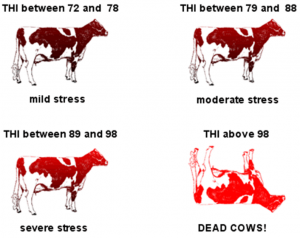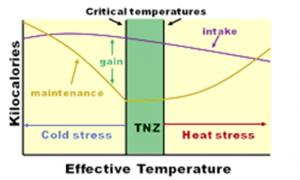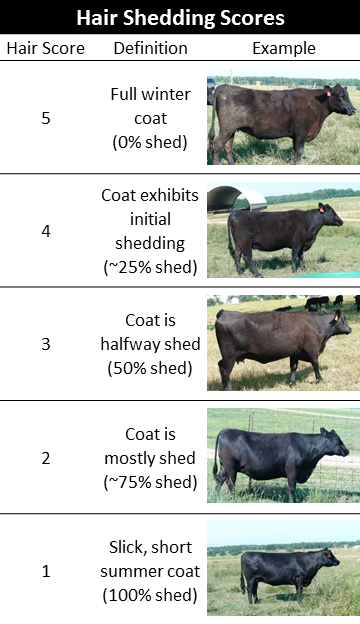Heat Stress and its effects on cattle production performance
News of mass cattle casualties’ due to intense temperatures in the central plains this past week has raised a lot of concern and awareness throughout the beef industry. Abnormally high temperatures and heat indexes well over 100 degrees have put a strain on cattle and producers. It is important to understand the thresholds of heat exposure for livestock and how it affects their body functions and productivity.
–
Heat stress and Temperature-Humidity Index
To better understand the effects of temperature on livestock, it’s best to examine two separate terms: Thermoneutral Zone (TNZ) and Temperature-Humidity Index (THI). Thermoneutral Zone is the range in effective temperature where rate and efficiency of performance are maximized. TNZ for healthy cattle is when they do not have to expend energy to maintain normal bodily function. Generally, this range is from 32⁰ and 77⁰ F. Energy use can differ between the two extremes, in cold weather cattle may start shivering and increase body movement to create heat energy. In hot weather, cattle may increase labored breathing to remove heat and increase salivary production. Animals that live in areas of the country that have higher humidity and a more subtropical climate will be more likely to have the onset of heat stress. THI is defined by the National Weather Service as what the temperature feels like to the body when relative humidity is combined with the air temperature. High humidity can increase the “feel” of the ambient temperature up to 10-15 degrees hotter thus increasing the likelihood of heat disorders. The figure below shows the range at which cattle enter dangerous heat stress, possibly leading to death.

‘Climate change and risk of thermal stress
in dairy cattle’ by Roger Jones, CSIRO Centre
for Atmospheric and Marine Research.
How do cattle dissipate heat?
Heat loss in cattle is conducted through evaporative cooling which includes sweat gland activity and respiration. It has also been studied that hair coat, color, length, and thickness all play a role in how a cow can effectively dissipate heat from their body. Bos indicus breeds have better heat regulatory capacities due to differences in metabolic rate, food and water consumption, sweating rate, and coat characteristics and color (Finch, 1986). Metabolic heat loss from the skin is determined by the differences between the skin and coat surface as well as the coat’s resistance to heat transfer (Finch, 1986).
At high ambient temperatures during the day, most heat loss occurs through evaporative cooling. Reduction of heat gain during the day and facilitation of heat loss at night is important to the maintenance of optimum reproductive performance. The average length of estrus is about 5 hrs. shorter in high-temperature locations.
–
Research on hair shedding and head adaptability
Over the past 10 plus years, several Land-Grant Universities have been studying heat adaptability in British breeds of cattle. The focus was on the ability of those breeds to prepare for the warmer weather by shedding their winter coats at an earlier time to reduce the heat load on their bodies. Multiple methods of observation were conducted including visual shedding scores, thermal imaging, and hair density records.
–
Hair shedding scores are simply a visual appraisal of the extent of hair shedding by a trained observer and are reported on a 1 to 5 scale. Half scores, such as 3.5, are not reported. A score of 5 indicates an animal that retains its complete winter coat and exhibits no evidence of shedding. At the other end of the scoring scale, a score of 1 is given when cattle have completely shed their winter coat and exhibit a slick, “summer” hair coat. Earlier shedding can be an indication of improved productivity and adaptation to the production environment. Hair shedding may have a direct effect on heat loss or it is possibly an indicator of another process (e.g., nutrition or immune status). Regardless, calves from cows that quickly shed their winter coat weigh more at weaning, with some estimates as large as 24-pounds. Additional information can be found in the resources below.
Recently, the American Angus Association announced a new EPD for Heat Adaptability with the Hair Shed (HS) figure on pedigrees. The Hair Shed EPD, is expressed in units of hair shed score, with a lower EPD being more favorable indicating a sire that should produce progeny who shed their winter coat earlier in the spring. Selection for this trait should improve the genetic potential for a sire’s progeny to shed off earlier increasing the environmental adaptability of cattle living in heat-stressed areas.
–
Ways to reduce heat stress in livestock.
As we have explained, increased exposure to high temperatures for long periods can have a detrimental effect on the function and productivity of cattle. Proper steps to decrease this exposure can lessen the negative effects. Some methods to consider:
- Plenty of fresh water available in various locations of the barn, paddock, or pasture. Some cattle have access to ponds, but there can be concerns with water quality for cattle who can physically enter the water.
- Shade structures: these can include natural covers such as trees or fabricated structures with shade cloth. Portable shade structures offer the ability to move them around the pasture and not wear down a particular area as cattle will tend to spend extended time under them.
- Fans & mister systems in more confined areas. Much data from dairy production has shown that air temperature can drop as much as 15 degrees with the combination.
- Earlier or later feeding times. Temperatures are usually lowest during the early morning hours and right at dusk. As most cattle come out of the shade to get to the feeding area, consider the distribution of grain during cooler times of the day.
–
References
Hair shedding scores: A tool to select heat tolerant cattle
Explain the concepts of thermoneutral zone, lower critical temperature, and upper critical temperature, and how they relate to metabolic rate
Hair Shedding FAQ
- Recap of the 2024 Panhandle Small Ruminant Nutrition Workshop - March 15, 2024
- Florida Cattlemen’s Leadership Academy Kicks Off Class IX - September 16, 2022
- Understanding Heat Stress in Cattle - June 24, 2022



